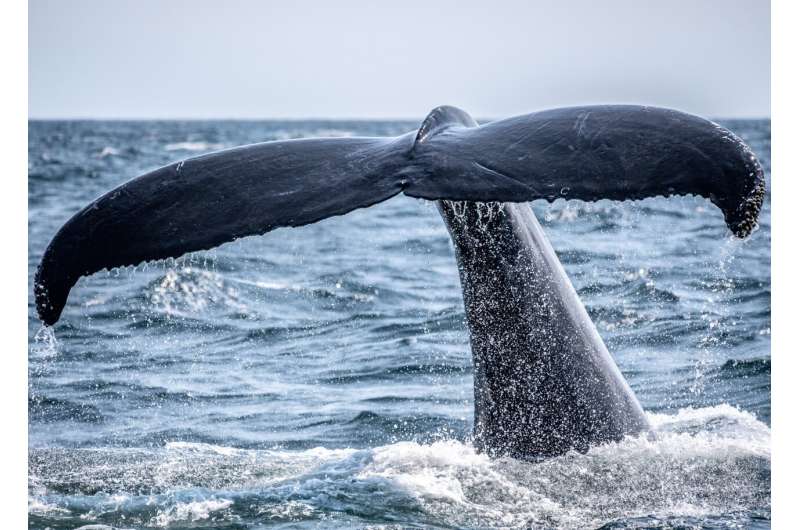This article has been reviewed according to Science X's editorial process and policies. Editors have highlighted the following attributes while ensuring the content's credibility:
fact-checked
peer-reviewed publication
trusted source
proofread
Interesting facts about Southern right whales

During Australia's winter months, Southern right whales can be spotted off the coastline. These whales are traveling north to warmer waters to breed and calve, after spending the summer months feeding in sub-Antarctic waters.
You'll likely see Humpback whales off Australian shores. But you might catch a glimpse of a Southern right whale. What makes these majestic creatures so special?
Southern right time
The Southern right whale—a baleen whale—is so-named because it was known as the "right" whale to hunt. It's a slow-moving whale and has high oil content, so populations were reduced to near extinction levels in the 19th century.
This species is now listed as endangered under the Environment Protection and Biodiversity Conservation Act 1999.
In Victoria, its conservation status was re-assessed from critically endangered in 2013 to endangered in 2020. Southern right whales can be spotted along the Bass Coast around Phillip Island and Wilson's Promontory during migration months.
Spotting the right whale
Southern right whales (Eubalaena australis) are one of the easiest species of whales to identify. They are stocky, have a broad head with a pale "bonnet," no dorsal fin and paddle-shaped flippers. They have two blowholes—the equivalent of our nostrils—and their flukes are usually black.
Southern right whales are mostly found further south than Humpback whales (which travel further north to more tropical calving grounds). Humpback whales are frequently seen offshore in Australia by whale watchers, but they look a bit different.
Humpbacks have very long flippers and a small dorsal fin. Southern right whales have smaller flippers, but they are also highly acrobatic. They can flip themselves upside down vertically (like a head stand) and breach like humpbacks do. They can wave their fluke in the air and use it to "sail" with the wind.
Both species are impressively large, measuring around 14 to 16 meters. But the largest animal on the planet, the Blue whale, can grow to twice this size.
Southern right whales have their own version of unique fingerprints—their callosity patterns on their heads can be used to identify them.
Each whale has a unique pattern of these patches of roughened skin. These are made from small hitchhikers including barnacles, whale lice and parasitic worms, which attach to these whales soon after birth.
Mum's the word for migration routes
It's best not to disturb a Southern right whale while she's nursing a new calf. It takes a huge amount of energy to raise a whale-sized baby, with females losing about 25% of their body volume over a three-month breeding season.
After taking 10 years to mature, Southern right females breed about every three years. A whale calf stays with its mum for one year after birth.
An Australian-led study, published in Nature in 2015, found Southern right whales learn their migration routes from their mothers. So where they go to breed is a cultural tradition that in turn affects how much mixing occurs between whales in different areas.
This means there are genetic differences between whales that breed around the Great Australian Bight and those that migrate through Tasmania, Victoria and New South Wales. There are also distinct genetic differences between Australia's Southern right whales and the sub-populations that breed off other southern hemisphere countries, including South Africa, Argentina-Brazil, Chile-Peru and even New Zealand.
Counting whales from space
Whales are hard to count in the ocean. But because they're so big, scientists have successfully managed to count them from space.
Researchers from the British Antarctic Survey (BAS) used satellite imagery, with some image processing and automatic detection software, to count Southern right whales breeding off Argentina.
Scientists are also exploring deep learning technologies that can be used with satellite images as wildlife surveying techniques.
While we've seen increasing numbers of Southern right whales visiting Australian shores every winter, our research suggests climate change poses a new and formidable threat to baleen whales.
Our modeling suggests Southern right whales in the Pacific Ocean, in particular, are highly vulnerable to climate change because of projected changes in the krill and copepods these whales rely on.
Our researchers used a MICE (Model of Intermediate Complexity) to work out how many whales there used to be. Using this data, and historical catch records, we estimated populations of Southern right whales today are about 10% of what they once were.
Northern right now
The Southern right whale's cousin, a species called the Northern right whale, used to be abundant in the North Pacific and North Atlantic Oceans. But these populations are now critically endangered and rate among the most endangered of all whale populations. Their future remains uncertain.
There are more human activities in the waters where Northern right whales live than in the southern hemisphere. These whales are sensitive to collisions and noise from boats, entanglement in fishing gear, coastal development and pollution, offshore oil spills, loud underwater sounds or explosions, as well as climate change.
Journal information: Nature
Provided by CSIRO




















